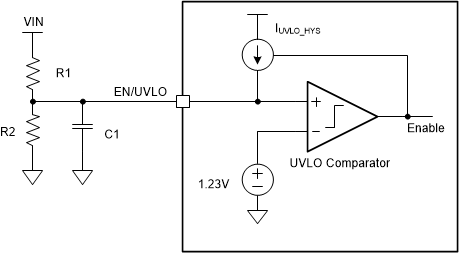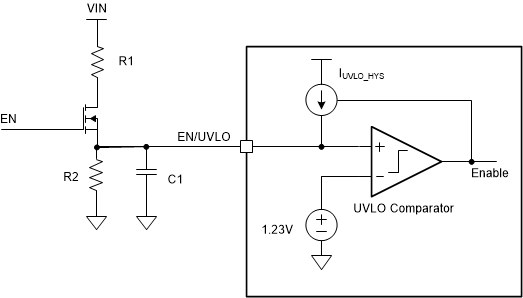SLVSGT4A December 2023 – January 2024 TPS61289
PRODUCTION DATA
- 1
- 1 Features
- 2 Applications
- 3 Description
- 4 Pin Configuration and Functions
- 5 Specifications
-
6 Detailed Description
- 6.1 Overview
- 6.2 Functional Block Diagram
- 6.3
Feature Description
- 6.3.1 Bidirectional Operation Configuration
- 6.3.2 VCC Power Supply
- 6.3.3 VHIGH and VCC Undervoltage Lockout (UVLO)
- 6.3.4 Enable and Programmable EN/UVLO
- 6.3.5 Switching Frequency
- 6.3.6 Programmable Switching Peak and Valley Current Limit
- 6.3.7 External Clock Synchronization
- 6.3.8 VHIGH Overvoltage Protection
- 6.3.9 Thermal Shutdown
- 7 Application and Implementation
- 8 Device and Documentation Support
- 9 Revision History
- 10Mechanical, Packaging, and Orderable Information
Package Options
Mechanical Data (Package|Pins)
- RZP|14
Thermal pad, mechanical data (Package|Pins)
Orderable Information
6.3.4 Enable and Programmable EN/UVLO
The TPS61289 has a dual function enable and undervoltage lockout (UVLO) circuit. When the voltage at the VHIGH pin and VCC pin is above the rising threshold of UVLO and the EN/UVLO pin is pulled above 1.15V but below the enable EN/UVLO threshold of 1.23V, the TPS61289 is enabled but still in standby mode.
The EN/UVLO pin has an accurate UVLO voltage threshold to support programmable input undervoltage lockout with hysteresis. When the EN/UVLO pin voltage is greater than the UVLO threshold of 1.23V, the TPS61289 is enabled for switching operation. A hysteresis current, IUVLO_HYS, is sourced out of the EN/UVLO pin to provide a hysteresis that prevents on or off chatter in the presence of noise with a slowly changing input voltage. The input voltage can be the voltage of the VLOW or VHIGH pin.
By using resistor divider as shown in Figure 6-1, the turn-on threshold is calculated using Equation 1.
where
- VUVLO is the UVLO threshold of 1.23V at the EN/UVLO pin.
- VIN can be the voltage of VLOW or VHIGH pin.
The hysteresis between the UVLO turn-on threshold and turn-off threshold is set by the upper resistor in the EN/UVLO resistor divider and is given by Equation 2.
where
- IUVLO_HYS is the sourcing current from the EN/UVLO pin when the voltage at the EN/UVLO pin is above VUVLO.
 Figure 6-1 Programmable UVLO With
Resistor Divider at the EN/UVLO Pin
Figure 6-1 Programmable UVLO With
Resistor Divider at the EN/UVLO PinBy using an NMOSFET together with a resistor divider the user can implement both logic enable and programmable UVLO as shown in Figure 6-2. The EN logic high level must be greater than the enable threshold plus the Vth of the NMOSFET Q1. The Q1 also eliminates the leakage current from VIN to ground through the UVLO resistor divider during shutdown mode.
 Figure 6-2 Logic Enable and Programmable
UVLO
Figure 6-2 Logic Enable and Programmable
UVLO